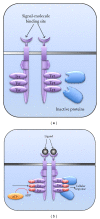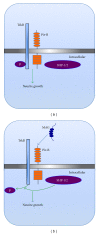Receptor tyrosine kinases: molecular switches regulating CNS axon regeneration
- PMID: 22848811
- PMCID: PMC3405719
- DOI: 10.1155/2012/361721
Receptor tyrosine kinases: molecular switches regulating CNS axon regeneration
Abstract
The poor or lack of injured adult central nervous system (CNS) axon regeneration results in devastating consequences and poor functional recovery. The interplay between the intrinsic and extrinsic factors contributes to robust inhibition of axon regeneration of injured CNS neurons. The insufficient or lack of trophic support for injured neurons is considered as one of the major obstacles contributing to their failure to survive and regrow their axons after injury. In the CNS, many of the signalling pathways associated with neuronal survival and axon regeneration are regulated by several classes of receptor tyrosine kinases (RTK) that respond to a variety of ligands. This paper highlights and summarises the most relevant recent findings pertinent to different classes of the RTK family of molecules, with a particular focus on elucidating their role in CNS axon regeneration.
Figures




Similar articles
-
The Virtuous Cycle of Axon Growth: Axonal Transport of Growth-Promoting Machinery as an Intrinsic Determinant of Axon Regeneration.Dev Neurobiol. 2018 Oct;78(10):898-925. doi: 10.1002/dneu.22608. Epub 2018 Jul 10. Dev Neurobiol. 2018. PMID: 29989351 Review.
-
Neuronal, but not glial, Contactin 2 negatively regulates axon regeneration in the injured adult optic nerve.Eur J Neurosci. 2021 Mar;53(6):1705-1721. doi: 10.1111/ejn.15121. Epub 2021 Mar 18. Eur J Neurosci. 2021. PMID: 33469963
-
Neuronal intrinsic barriers for axon regeneration in the adult CNS.Curr Opin Neurobiol. 2010 Aug;20(4):510-8. doi: 10.1016/j.conb.2010.03.013. Epub 2010 Apr 24. Curr Opin Neurobiol. 2010. PMID: 20418094 Free PMC article.
-
Return of function after CNS axon regeneration: Lessons from injury-responsive intrinsically photosensitive and alpha retinal ganglion cells.Prog Retin Eye Res. 2019 Jul;71:57-67. doi: 10.1016/j.preteyeres.2018.11.006. Epub 2018 Nov 17. Prog Retin Eye Res. 2019. PMID: 30458239 Review.
-
Mechanisms of Axon Elongation Following CNS Injury: What Is Happening at the Axon Tip?Front Cell Neurosci. 2020 Jul 3;14:177. doi: 10.3389/fncel.2020.00177. eCollection 2020. Front Cell Neurosci. 2020. PMID: 32719586 Free PMC article.
Cited by
-
Osteoclast-derived extracellular vesicles are implicated in sensory neurons sprouting through the activation of epidermal growth factor signaling.Cell Biosci. 2022 Aug 14;12(1):127. doi: 10.1186/s13578-022-00864-w. Cell Biosci. 2022. PMID: 35965312 Free PMC article.
-
High-throughput screen for compounds that modulate neurite growth of human induced pluripotent stem cell-derived neurons.Dis Model Mech. 2018 Feb 2;11(2):dmm031906. doi: 10.1242/dmm.031906. Dis Model Mech. 2018. PMID: 29361516 Free PMC article.
-
Beneficial Effects of Neurotrophin-4 Supplementation During in vitro Maturation of Porcine Cumulus-Oocyte Complexes and Subsequent Embryonic Development After Parthenogenetic Activation.Front Vet Sci. 2021 Nov 12;8:779298. doi: 10.3389/fvets.2021.779298. eCollection 2021. Front Vet Sci. 2021. PMID: 34869748 Free PMC article.
-
Analysis of Gene Expression and Neuronal Phenotype in Neuroscreen-1 (NS-1) Cells.Int J Biomed Investig. 2018 Sep-Dec;1(3):115. Epub 2018 Dec 17. Int J Biomed Investig. 2018. PMID: 30687846 Free PMC article.
-
Extracellular and Intracellular Factors in Brain Cancer.Front Cell Dev Biol. 2021 Aug 27;9:699103. doi: 10.3389/fcell.2021.699103. eCollection 2021. Front Cell Dev Biol. 2021. PMID: 34513834 Free PMC article. Review.
References
-
- Li Y, Raisman G. Sprouts from cut corticospinal axons persist in the presence of astrocytic scarring in long-term lesions of the adult rat spinal cord. Experimental Neurology. 1995;134(1):102–111. - PubMed
-
- Horner PJ, Gage FH. Regenerating the damaged central nervous system. Nature. 2000;407(6807):963–970. - PubMed
-
- Cao Z, Gao Y, Deng K, Williams G, Doherty P, Walsh FS. Receptors for myelin inhibitors: structures and therapeutic opportunities. Molecular and Cellular Neuroscience. 2010;43(1):1–14. - PubMed
Grants and funding
LinkOut - more resources
Full Text Sources

